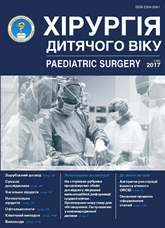Improvement of the diagnosis and surgical treatment of necrotizing enterocolitis in newborns
DOI:
https://doi.org/10.15574/PS.2017.55.76Keywords:
necrotizing enterocolitis, neonates, ultrasonography, inflammatory mediators, surgical treatment, primary anastomosisAbstract
Objective: to summarize the own experience of using ultrasonography (US) with Doppler sonography to determine the level and extent of bowel lesion and solve the issue of further surgical tactics in the treatment of newborns with necrotizing enterocolitis (NEC).Material and methods. The work based on the results of the pro- and retrospective study analysis of 111 newborns’ examination with necrotizing enterocolitis. Among them, 79 (71.2%) newborns were operated and 32 (28.2%) received the conservative treatment. The diagnosis was determined based on the results of physical examination and instrumental (X-ray, US and Doppler sonography) methods. In 41 (66.1%) cases the stoma was formed after the resection, and in 21 (33.9%) cases the intervention was completed with the superimposition of primary anastomosis.
Results. The total mortality among newborns after surgical treatment made up 17.7% (11 infants), including 19.5% (8 newborns) with the stoma formation and 14.3% (3 children) with the initial anastomosis. The various postoperative complications were observed in 17 (41.5%) children with stoma formation and in 5 (23.8%) patients after initial anastomosis. The post-operative lethality was 22.8%.
Conclusions. The prognostic value of the results of clinical, laboratory and instrumental methods of examination relative to the severity of damage in necrotizing enterocolitis was determined. The significance of examination results in diagnosing the severity of disease was proved. The high informative value of determining the levels of inflammatory mediators and Doppler sonography as non-invasive diagnostic methods based on the results of the research was confirmed. The use of Doppler sonography before the surgery allows detecting circulatory disturbances in the intestinal wall before the occurrence of perforation allowing to perform surgery at the most optimal time as well as to prevent peritonitis. It has been proposed to include drugs with anti-cytokine properties (pentoxifylline) in the complex of conservative therapy; it will allow reducing the negative influence of mediators of the inflammatory response and, consequently, improving the clinical course of disease. The use of intraoperative Doppler sonography will allow to clearly defining the boundaries of healthy and damaged intestine; it will enable to apply primary anastomosis as well as to preventive intestinal stoma.
References
Bairov VG, Karavaeva SA. (2002). Ob opyite hirurgicheskogo lecheniya nekroticheskogo enterokolita. Sbornik nauch trudov. Saratov: 16–20.
Karpova IYu, Parshikov VV, Egorskaya LE. (2012). Rol instrumentalnyih metodov issledovaniya v diagnostike nekroticheskogo enterokolita u novorozhdennyih. Vestnik eksperiment i klin hirurgii. 2: 412–415.
Klimenko TM, Vorobeva OV. (2011). Patogeneticheskie podhodyi k ranney diagnostike nekrotiziruyuschego enterokolita nedonoshennyih novorozhdennyih. NeonatologIya, hIrurgIya ta perinatalna meditsina. 1: 24–40.
Pereiaslov AA. (2007). Rol tsytokiniv pry nekrotychnomu enterokoliti u ditei. Paediatric Surgery. Ukraine. 4: 8–17.
Berseth CL, Bisquera JA, Paje VU. (2003). Prolonging small feeding volumes early in life decreases the incidence of necrotizing enterocolitis in very low birth weight infants. Pediatrics. 111: 671–672. https://doi.org/10.1542/peds.111.3.529
Bhatia J. (2010). Strategies to prevent necrotising enterocolitis. Chin Med J. 123: 2759–2765.
Gupta A, Paria A. (2016). Etiology and medical management of NEC. Early Hum Dev. 97: 17–23. https://doi.org/10.1016/j.earlhumdev.2016.03.008; PMid:27080373
Hunter CJ, De Plaen IG. (2014). Inflammatory signaling in NEC: Role of NF-κB, cytokines and other inflammatory mediators. Pathophysiology. 21: 55–65. https://doi.org/10.1016/j.pathophys.2013.11.010; PMid:24388163 PMCid:PMC4354685
Kastenberg ZJ, Sylvester KG. (2013). The surgical management of necrotizing enterocolitis. Clin Perinatol. 40: 135–148. https://doi.org/10.1016/j.clp.2012.12.011; PMid:23415269
Kim JH. (2014). Necrotizing enterocolitis: The road to zero. Semin Fetal Neonatal Med. 19: 39–44. https://doi.org/10.1016/j.siny.2013.10.001; PMid:24268863
Luig M, Lui K. (2005). Epidemiology of necrotizing enterocolitis – part I: changing regional trends in extremely preterm infants over 14 years. NSW & ACT NICUS Group. J Paediatr Child Health. 41: 169–173. https://doi.org/10.1111/j.1440-1754.2005.00582.x; PMid:15813869
Maheshwari A. (2015). Immunologic and hematological abnormalities in necrotizing enterocolitis. Clin Perinatol. 42: 567–585. https://doi.org/10.1016/j.clp.2015.04.014; PMid:26250918 PMCid:PMC4530495
Muller MJ, Paul T, Seeliger S. (2016). Necrotizing enterocolitis in premature infants and newborns. J Neonatal Perinatal Med. 9: 233–242. https://doi.org/10.3233/NPM-16915130; PMid:27589549
Downloads
Issue
Section
License
The policy of the Journal “PAEDIATRIC SURGERY. UKRAINE” is compatible with the vast majority of funders' of open access and self-archiving policies. The journal provides immediate open access route being convinced that everyone – not only scientists - can benefit from research results, and publishes articles exclusively under open access distribution, with a Creative Commons Attribution-Noncommercial 4.0 international license(СС BY-NC).
Authors transfer the copyright to the Journal “PAEDIATRIC SURGERY.UKRAINE” when the manuscript is accepted for publication. Authors declare that this manuscript has not been published nor is under simultaneous consideration for publication elsewhere. After publication, the articles become freely available on-line to the public.
Readers have the right to use, distribute, and reproduce articles in any medium, provided the articles and the journal are properly cited.
The use of published materials for commercial purposes is strongly prohibited.

